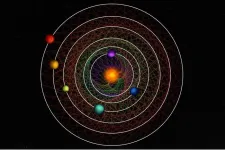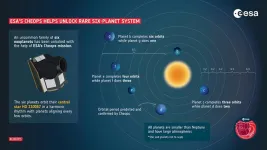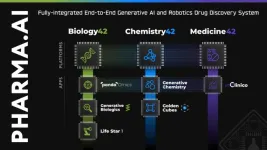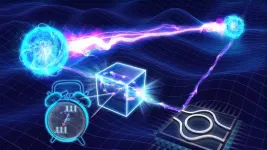(Press-News.org) Have you ever wondered why we carry two copies of each chromosome in all of our cells? During reproduction, we receive one from each of our parents. This means that we also receive two copies, or alleles, of each gene – one allele per chromosome or parent.
Both alleles are able to produce messenger RNA, which is the recipe needed to make proteins and keep cells running. Scientists hypothesize that having two alleles for each gene is the cell’s in-built redundancy system. If there is ever a mutation or drop in messenger RNA production from the allele carried on one of the chromosomes, the allele on the second chromosome will serve as a backup and will be able to step up to produce sufficient messenger RNA output to compensate for loss of the first allele. This redundancy enables us as humans to be largely resistant to the effects of recessive mutations.
However, a class of genes known as haploinsufficient genes, rely on the continuous expression of two intact alleles. If just one allele of a haploinsufficient gene is compromised, it will lead to human disease. It was therefore hypothesized that the cell may have a special “safety” mechanism to safeguard the messenger RNA expression from this special class of genes. A study featured in the scientific journal Nature led by Asifa Akhtar discovered exactly such a mechanism.
MSL2 is an epigenetic dosage-sensor
The researchers found that the epigenetic regulator MSL2 guarantees the expression of both alleles of specific haploinsufficient genes, ensuring the right messenger RNA dosage. This is crucial because genes require different dosage depending on the tissues they are expressed in. With MSL2, the team has identified, for the first time, a protein that can sense these dosage-sensitive genes and ensure their biallelic expression in the relevant tissue or developmental stage.
“We were always wondering whether the copy of the gene on the chromosome coming from the mother could communicate with the second copy on the chromosome coming from the father. Our findings imply an underlying communication between the two alleles and we speculate that MSL2 ensures that mom and dad can talk to each other – at least molecularly,” says Asifa Akhtar, Director at the Max Planck Institute of Immunobiology and Epigenetics in Freiburg.
Tracking down the allelic regulator with a genetic trick
Fascinated by their discovery of a mechanism which safeguards the biallelic expression of haploinsufficient genes, the researchers investigated how this MSL2 mechanism works at the molecular level. To tackle this, the team used a trick. "We crossed genetically distant mouse strains with each other - a bit like crossing a Chihuahua with a Great Dane. This allowed us to see which alleles were inherited from the mother and which from the father," says Yidan Sun, the first author of the paper, explaining the method of allele-specific gene expression analysis. With this hybrid mouse system, the team could analyze the activity of individual alleles. She adds: "In contrast to the standard method of expression data analysis, in which the gene products are summed over the two alleles, this gave us the resolution necessary to track the expression status of each allele individually".
A future for novel therapeutic strategies to address diseases
Their experiments demonstrated that when MSL2 was lost in hybrid mouse cells, certain haploinsufficient genes could only achieve monoallelic expression. This implies that in mammalian cells, MSL2 is necessary for the biallelic expression of genes, ensuring their functionality and, consequently, the overall health of the organism. Interestingly, many of the haploinsufficient genes regulated by MSL2 are associated with neurological disorders.
“But what adds a fascinating layer to this discovery is the tissue- and cell-type specificity of these genes. Looking at the organism as a whole, it makes you wonder whether a backup system orchestrated by epigenetic factors such as MSL2 might explain why people, even with similar lifelong habits like smoking or diet, have different health outcomes or disease risks," says Meike Wiese, one of the first authors of the study.
An evolutionarily conserved mechanism that regulates gene dosage
“My lab started out studying dosage compensation in fruit flies, which is the process by which males with one X chromosome can achieve the same level of gene products as females with two X chromosomes. Over the years we have been fascinated by how male fruit flies with just one X chromosome do double duty to produce the same messenger RNA compared to the females with two X chromosomes. Without this double dose males simply die! It looks like this strategy has been cleverly adapted by mammals. Our results clearly illustrate how the same tools, like MSL2, are again used in evolution to regulate dosage of genes. Gene dosage matters, and our study provides a new level of understanding of how the cells in our body ensure that we get the right dose of messenger RNAs,” says Asifa Akhtar.
What truly excites the scientists is that this discovery opens new directions to delve deeper into understanding the modulation of gene dosage within our cells. MSL2, as revealed, may just be one example of such an allelic regulator, suggesting the existence of other factors performing similar roles. This newfound knowledge carries profound implications for understanding diseases and holds promise for developing potential treatments.
END
Revisiting gene dosage
Max Planck research reveals clever dosage control mechanism of biallelic genes
2023-11-29
ELSE PRESS RELEASES FROM THIS DATE:
Scientists discover rare 6-planet system that moves in strange synchrony
2023-11-29
Scientists have discovered a rare sight in a nearby star system: Six planets orbiting their central star in a rhythmic beat. The planets move in an orbital waltz that repeats itself so precisely it can be readily set to music.
A rare case of an “in sync” gravitational lockstep, the system could offer deep insight into planet formation and evolution.
The analysis, led by UChicago scientist Rafael Luque, will be published Nov. 29 in Nature.
“This discovery is going to become a benchmark system to study how sub-Neptunes, the most common type of planets outside of the solar system, form, evolve, what are they made of, and if they possess the ...
Disruptive ideas rely on old fashioned meetings
2023-11-29
A marvel of modernity is the ability to collaborate with others regardless of location. Researchers can work with a colleague, maybe the only person who has a specialized skill, even if they are halfway across the globe. They can pull together a powerhouse team with a dozen of the brightest minds in the field.
Yet, according to research from the lab of Lingfei Wu, assistant professor in Pitt’s School of Computing and Information, these collaborative teams are producing fewer truly disruptive ideas or radical innovations than ...
An astronomical waltz reveals a sextuplet of planets
2023-11-29
An international collaboration between astronomers using the CHEOPS and TESS space satellites, including NCCR PlanetS members from the University of Bern and the University of Geneva, have found a key new system of six transiting planets orbiting a bright star in a harmonic rhythm. This rare property enabled the team to determine the planetary orbits which initially appeared as an unsolvable riddle.
CHEOPS is a joint mission by ESA and Switzerland, under the leadership of the University of Bern in collaboration with the University of Geneva. Thanks to a collaboration with scientists ...
Final call for Awards Nominations 2024 of the World Cultural Council
2023-11-29
The World Cultural Council (WCC) is now accepting nominations for the “Albert Einstein” World Award of Science and the “Leonardo da Vinci” World Awards of Arts.
Nominations must be submitted by 26 January, 2024. NOMINATE NOW: To nominate online or for further details of the awards visit the WCC website Nominations page.
Ideal candidates for the “Albert Einstein” World Award of Science are scientists whose achievements can serve as an inspiration for future generations. This award is granted each year. Consideration will be given to ...
BU/VA researcher awarded funding to prevent intimate partner violence
2023-11-29
(Boston)—Casey Taft, PhD, professor of psychiatry at Boston University Chobanian & Avedisian School of Medicine, has been approved for a five-year, $2.8 million funding award from the Patient-Centered Outcomes Research Institute (PCORI) for his research study “A Randomized Controlled Trial to Evaluate a Trauma-Informed Partner Violence Intervention Program.”
Taft, who also is a staff psychologist at the National Center for PTSD in the VA Boston Healthcare System, is conducting a randomized controlled trial of the Strength at Home program to prevent and end intimate partner violence (IPV) in Rhode Island. Strength at Home ...
The act of saying "no" under the linguistic magnifying glass
2023-11-29
FRANKFURT. Prof. Bernhard Brüne, Vice President Research, Early Career Researchers and Transfer at Goethe University Frankfurt, congratulated the researchers involved in the successful application: "Anyone who establishes a major project like a Collaborative Research Center must have both creative and viable research ideas as well as a strong network. To discover new things about language and thinking, the new CRC 1629 not only makes use of Goethe University’s structures, and the combination of philology with philosophy and didactics. It also cooperates with partner universities in Göttingen and Tübingen. Aside that, I am of course delighted that ...
Insilico Medicine showcases latest AI drug discovery platform breakthroughs
2023-11-29
Insilico Medicine (“Insilico”), an artificial intelligence (AI)-driven, clinical stage biotechnology company and leader in AI drug discovery platform technology, is hosting three webinars unveiling its latest technology breakthroughs Nov. 28-30, 2023. These new features are part of the expansion of the Company’s end-to-end Pharma.AI platform and include chat functionality, off-target screening tools, enhanced knowledge graphs and more. They represent major steps forward in the advancement of AI drug discovery.
The company is an early ...
New astrophysics model sheds light on additional source of long gamma-ray bursts
2023-11-29
Cutting-edge computer simulations combined with theoretical calculations are helping astronomers better understand the origin of some of the universe’s most energetic and mysterious light shows — gamma-ray bursts, or GRBs. The new unified model confirms that some long-lasting GRBs are created in the aftermath of cosmic mergers that spawn an infant black hole surrounded by a giant disk of natal material.
Astronomers previously thought that black holes that generate long GRBs typically form when massive ...
Brain scans of former NFL athletes show a repair protein in place long after initial injury
2023-11-29
FOR IMMEDIATE RELEASE
In a new study using brain scans of former NFL athletes, Johns Hopkins Medicine researchers say they found high levels of a repair protein present long after a traumatic brain injury such as a concussion takes place. The repair protein, known as 18 kDa translocator protein (TSPO), is known to be present in the brain at high levels in the immediate aftermath of brain injury as part of the inflammatory response and to facilitate repair. The new findings, published Oct. 30 in JAMA Network Open, suggest that brain injury and repair processes persist for years after players end collision sports careers, and lead to long-term cognitive ...
Long-live quantum entanglement goes to distance
2023-11-29
Quantum technologies are currently maturing at a breath-taking pace. These technologies exploit principles of quantum mechanics in suitably engineered systems, with bright prospects such as boosting computational efficiencies or communication security well beyond what is possible with devices based on today’s 'classical' technologies. As with classical devices, however, to realise their full potential, quantum devices will need to be networked. In principle, this can be done using the fibre-optic networks employed for classical telecommunications. But practical implementation requires that the information ...
LAST 30 PRESS RELEASES:
Reviving dormant immunity: Millimeter waves reprogram the immunosuppressive microenvironment to potentiate immunotherapy without obvious side effects
Safety decision-making for autonomous vehicles integrating passenger physiological states by fNIRS
Fires could emit more air pollution than previously estimated
A new way to map how cells choose their fate
Numbers in our sights affect how we perceive space
SIMJ announces global collaborative book project in commemoration of its 75th anniversary
Air pollution exposure and birth weight
Obstructive sleep apnea risk and mental health conditions among older adults
How talking slows eye movements behind the wheel
The Ceramic Society of Japan’s Oxoate Ceramics Research Association launches new international book project
Heart-brain connection: international study reveals the role of the vagus nerve in keeping the heart young
Researchers identify Rb1 as a predictive biomarker for a new therapeutic strategy in some breast cancers
Survey reveals ethical gaps slowing AI adoption in pediatric surgery
Stimulant ADHD medications work differently than thought
AI overestimates how smart people are, according to HSE economists
HSE researchers create genome-wide map of quadruplexes
Scientists boost cell "powerhouses" to burn more calories
Automatic label checking: The missing step in making reliable medical AI
Low daily alcohol intake linked to 50% heightened mouth cancer risk in India
American Meteorological Society announces Rick Spinrad as 2026 President-Elect
Biomass-based carbon capture spotlighted in newly released global climate webinar recording
Illuminating invisible nano pollutants: advanced bioimaging tracks the full journey of emerging nanoscale contaminants in living systems
How does age affect recovery from spinal cord injury?
Novel AI tool offers prognosis for patients with head and neck cancer
Fathers’ microplastic exposure tied to their children’s metabolic problems
Research validates laboratory model for studying high-grade serous ovarian cancer
SIR 2026 delivers transformative breakthroughs in minimally invasive medicine to improve patient care
Stem Cell Reports most downloaded papers of 2025 highlight the breadth and impact of stem cell research
Oxford-led study estimates NHS spends around 3% of its primary and secondary care budget on the health impacts of heat and cold in England
A researcher’s long quest leads to a smart composite breakthrough
[Press-News.org] Revisiting gene dosageMax Planck research reveals clever dosage control mechanism of biallelic genes





